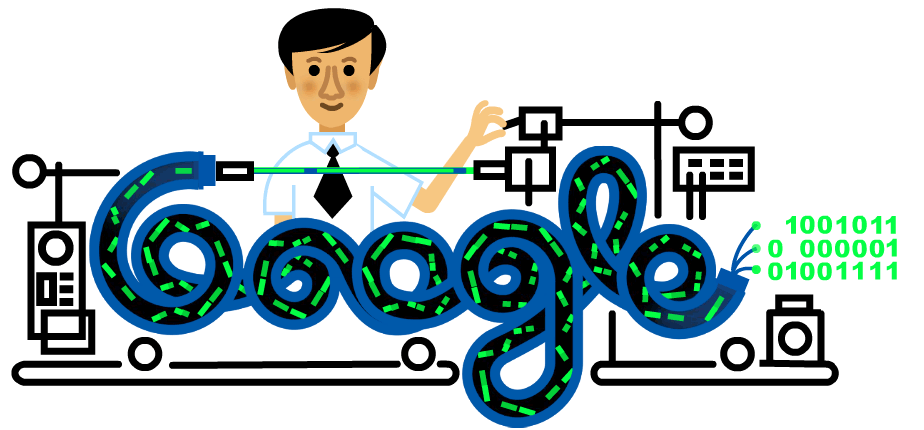Charles K. Kao ‘Father of Fiber Optics’: Google Celebrates Charles K. Kao’s 88th Birthday with Doodle
Charles K. Kao ‘Father of Fiber Optics’: Google Celebrates Charles K. Kao’s 88th Birthday with Doodle
Charles Kuen Kao is known as the “father of fiber optic communications” for his discovery in the 1960s of certain physical properties of glass, which laid the groundwork for high-speed data communication in the Information Age. Before Kao’s pioneering work, glass fibers were widely believed to be unsuitable as a conductor of information because of excessively high signal loss from light scattering. Kao realized that, by carefully purifying the glass, bundles of thin fibers could be manufactured that would be capable of carrying huge amounts of information over long distances with minimal signal attenuation and that such fibers could replace copper wires for telecommunication.
He shared the 2009 Nobel Prize in Physics with Canadian physicist Willard S. Boyle (1924-2011) and American scientist George E. Smith (1930-), coinventors of the charge-coupled device, which is used to convert optical information to an electrical signal. Fiber optics and charge-coupled devices made possible the broadband communications on which contemporary medical informatics and electronic publishing depend, as well as specific imaging devices in ophthalmologic equipment and microscopes.
Kao was born on November 4, 1933, in Shanghai, China. His father was a lawyer who received his JD degree from the University of Michigan (United States) in 1925 and became a professor at Soochow University (Shanghai). As a boy, Kao studied Chinese classics at home with a tutor and learned English and French at an international school in Shanghai.
Sears Mastercard Login : Sears Credit Card Log In or Apply Activate Sears Credit Card
Google Celebrates Charles K. Kao’s 88th Birthday with Doodle
Celebrated Chinese-born British-American physicist and educator Charles K. Kao is the subject of today’s Doodle. Kao is considered the father of fibre optics, and his innovations revolutionised global communication and laid the foundation for high-speed internet.
In 1933, Shanghai, China, Charles Kuen Kao was born. Early in life, he was drawn to intellectual work and achieved notable academic success; he then went on to study electrical engineering in the United Kingdom. He worked as an engineer at Standard Telephones and Cables Ltd., where he and his colleagues invented the laser in 1960, to help pay for his master’s studies.

For his contributions to Hong Kong’s Chinese University of Hong Kong, Kao was awarded an honorary doctorate in 1970. In 1974, he relocated to Roanoke, Virginia, where he worked for ITT Corporation, the parent company of Standard Telephones & Cables, as Chief Scientist and Director of Engineering.
Activate American Express Card : Step to Confirm your AMEX Card
This period saw the filing of a number of important patents relating to fibre optics. First Executive Scientist at ITT, Kao relocated to Connecticut in 1982, where he also taught at Yale University. In 1987, Kao was appointed Vice-Chancellor of the Chinese University of Hong Kong. For the rest of his life, he continued to serve as a visiting professor and other honorary positions.
May-wan Kao, a former Fortran programmer who he met while studying in London in the 1950s, and Kao moved to California in 2004 after being diagnosed with Alzheimer’s disease. Kao’s wife stated in an interview that the Nobel Prize money would be used to pay Kao’s medical expenses, perhaps the first time the award had been used for this purpose.
Hong Kong issued a stamp in 2010 to commemorate Charles K. Kao. Many honorary degrees have been bestowed on Kao, including the Faraday Medal in 1989; the Alexander Graham Medal in 1985; the Marconi Medal in 1985; and the Nobel Prize in physics in 1992.